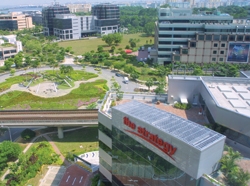
Singapore industrial and logistics rents to rise 5%: Colliers
Same with Hong Kong and New Delhi.
Meanwhile, industrial and logistics rentals are expected to grow by around 3 to 5% p.a. in most Chinese cities during 2013, as a result of continued growth in industrial production, cargo throughput volume and local retail sales, said Colliers International in a new briefing on logistics real estate investments in Asia,
"In particular, Beijing is taking the lead in Asia with industrial and logistics rents expected to rise by 10% p.a. in 2013, mainly due to the accelerating expansion of third-party logistics (3PL) companies and the e-commerce sector, as well as a lack of new supply of quality and modern logistics facilities in the city," Colliers said.
Colliers attributed the growing popularity of logistics warehouses in Asia in recent years to a notable shift in the interest of investors away from short-term capital appreciation and towards yields and income security.
The encouraging rental outlook of logistics warehouses has begun appealing to property investors. Their premium yields have also become a top attraction.
"The growing volatility of asset prices of commercial and residential real estate in Asia is encouraging investors to turn their attention away from these traditionally popular sectors and towards niche markets, such as logistics property, which offer them the benefits of stable rental income and premium yields," added Colliers International on why logistics warehouses investments are booming.
The region’s burgeoning industrial property market is becoming increasingly popular among investors. The CEIC’s monthly Asia Industrial Production Index – an aggregate indicator of overall industrial production volume – grew at a compound annual growth rate (CAGR) of more than 10% per annum (p.a.) between 2009 and 2012, the period following the global financial crisis, noted the research firm.
Meanwhile, China’s Industrial Production Index outpaced the regional figure, with a CAGR of 12.6% p.a., indicating that it is even more resilient to external challenges.
“Logistics is fundamentally a function of external trade. However, the significant increase of private consumption expenditure has gradually redefined the potential demand for logistics real estate in Asia,” says Simon Lo, Executive Director of Research & Advisory, Asia, at Colliers International.
Demographic factors are fuelling the increase in private consumption in the region. In 2010, about 45% of Asia’s 4.2 billion population was aged between 20 and 49, and the percentage is expected to remain largely unchanged up to 2020, according to figures released by the United Nations Department of Economics and Social Affairs. This younger population tends to have higher disposable incomes and spending capacity, which are driving the growth of private consumption in the region. Growing urbanisation – the Economist Intelligence Unit (EIU) forecasts that around 200 million more people will move to Asia’s cities between 2012 and 2017 – is also boosting private consumption.
"Besides the potential increase in demand for logistics fuelled by rising private consumption, the popularity of logistics warehouses in Asia in recent years has been due to a notable shift in the interest of investors away from short-term capital appreciation and towards yields and income security,” Lo adds.
Recent government policy changes have also created uncertainties in the residential and commercial property market, causing increasing concern among investors. This has affected investment activity in these sectors.
For example, the number of property transactions valued over HK$100 million recorded in Hong Kong was 29 in January and 32 in February 2013, more than the 2012 monthly average of 22. However, the figure fell sharply to 10 in March, five in April, and just one in May 2013.
“Property investment activity has significantly slowed down since the government’s announcement of the doubling of the ad valorem stamp duty rate in February 2013,” says Antonio Wu, Executive Director of Investment Services, Asia, and Deputy Managing Director, Hong Kong, at Colliers International.
“The growing risks arising from government policies and liquidity in some Asian markets have led investors to adopt a defensive attitude. Thus, they are increasingly going for yields instead,” Wu notes.
The average industrial capitalisation rate in Asia rebounded from an all-time low of 5.8% p.a. in 2Q 2012 to 7.1% p.a. in 1Q 2013. This represents a noteworthy premium yield compared to risk-free rates, such as the 10-year US bond yield of 1.95% p.a. in 1Q 2013.
























 Advertise
Advertise






